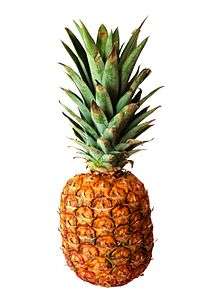Pineapple
The pineapple[2][3] (Ananas comosus) is a tropical plant with an edible fruit and the most economically significant plant in the family Bromeliaceae.[4] The pineapple is indigenous to South America, where it has been cultivated for many centuries. The introduction of the pineapple to Europe in the 17th century made it a significant cultural icon of luxury. Since the 1820s, pineapple has been commercially grown in greenhouses and many tropical plantations. Further, it is the third most important tropical fruit in world production. In the 20th century, Hawaii was a dominant producer of pineapples, especially for the US; however, by 2016, Costa Rica, Brazil, and the Philippines accounted for nearly one-third of the world's production of pineapples.[5]
| Pineapple | |
|---|---|
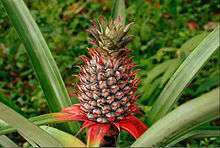 | |
| A pineapple on its parent plant | |
| Scientific classification | |
| Kingdom: | Plantae |
| Clade: | Tracheophytes |
| Clade: | Angiosperms |
| Clade: | Monocots |
| Clade: | Commelinids |
| Order: | Poales |
| Family: | Bromeliaceae |
| Genus: | Ananas |
| Species: | A. comosus |
| Binomial name | |
| Ananas comosus | |
| Synonyms[1] | |
|
List
| |
Pineapples grow as a small shrub; the individual flowers of the unpollinated plant fuse to form a multiple fruit. The plant is normally propagated from the offset produced at the top of the fruit,[2][6] or from a side shoot, and typically mature within a year.[6][7]
Botany
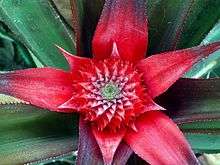
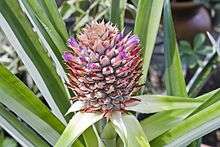
The pineapple is a herbaceous perennial, which grows to 1.0 to 1.5 m (3.3 to 4.9 ft) tall, although sometimes it can be taller. In appearance, the plant has a short, stocky stem with tough, waxy leaves. When creating its fruit, it usually produces up to 200 flowers, although some large-fruited cultivars can exceed this. Once it flowers, the individual fruits of the flowers join together to create a multiple fruit. After the first fruit is produced, side shoots (called 'suckers' by commercial growers) are produced in the leaf axils of the main stem. These may be removed for propagation, or left to produce additional fruits on the original plant.[6] Commercially, suckers that appear around the base are cultivated. It has 30 or more long, narrow, fleshy, trough-shaped leaves with sharp spines along the margins that are 30 to 100 cm (1.0 to 3.3 ft) long, surrounding a thick stem. In the first year of growth, the axis lengthens and thickens, bearing numerous leaves in close spirals. After 12 to 20 months, the stem grows into a spike-like inflorescence up to 15 cm (6 in) long with over 100 spirally arranged, trimerous flowers, each subtended by a bract.
The ovaries develop into berries, which coalesce into a large, compact, multiple fruit. The fruit of a pineapple is usually arranged in two interlocking helices, Typically there are eight in one direction and 13 in the other, each being a Fibonacci number.[8]
The pineapple carries out CAM photosynthesis,[9] fixing carbon dioxide at night and storing it as the acid malate, then releasing it during the day aiding photosynthesis.
The pineapple comprises five botanical varieties, formerly regarded as separate species:[10]
- Ananas comosus var. ananassoides
- Ananas comosus var. bracteatus
- Ananas comosus var. comosus
- Ananas comosus var. erectifolius
- Ananas comosus var. parguazensis
Pollination
In the wild, pineapples are pollinated primarily by hummingbirds.[2][11] Certain wild pineapples are foraged and pollinated at night by bats.[12] Under cultivation, because seed development diminishes fruit quality, pollination is performed by hand, and seeds are retained only for breeding.[2] In Hawaii, where pineapples were cultivated and canned industrially throughout the 20th century,[13] importation of hummingbirds was prohibited.[14]
English name
The first reference in English to the pineapple fruit was the 1568 translation from the French of André Thevet's The New Found World, or Antarctike where he refers to a Hoyriri, a fruit cultivated and eaten by the Tupinambá people, living near modern Rio de Janeiro, and now believed to be a pineapple.[15] Later in the same English translation, he describes the same fruit as a Nana made in the manner of a Pine apple, where he used another Tupi word nanas, meaning "excellent fruit".[16] This usage was adopted by many European languages and led to the plant's scientific binomial Ananas comosus, where comosus, "tufted", refers to the stem of the plant. Purchas, writing in English in 1613, referred to the fruit as Ananas, but the OED's first record of the word "pineapple" itself by an English writer by Mandeville in 1714.[17]
History
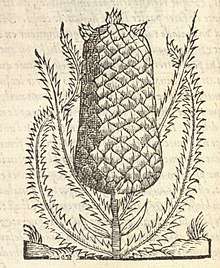
The wild plant originates from the Paraná–Paraguay River drainages between southern Brazil and Paraguay.[2][18][19] Little is known about domestication but it spread as a crop throughout South America, and it eventually reached the Caribbean, Central America, and Mexico, where it was cultivated by the Mayas and the Aztecs.[20] The first European to encounter the pineapple was Columbus, in Guadeloupe on 4 November 1493, by which time cropped pineapple was widely distributed and a stable component of the diet of native Americans.[21][22] The Portuguese took the fruit from Brazil and introduced it into India by 1550.[23] The 'Red Spanish' cultivar was also introduced by the Spanish from Latin America to the Philippines, and it was grown for textile use from at least the 17th century.[24][25]

Columbus brought the plant back to Spain and called it piña de Indes, meaning "pine of the Indians". The pineapple was documented in Peter Martyr's Decades of the New World in 1516 and Antonio Pigafetta's Le Voyage et Navigacion.. of 1526, and the first known illustration was in Oviedo's Historia General de Las Indias in 1535.[26]
The pineapple fascinated Europeans as a fruit of colonialism[27] but it could not be successfully cultivated in Europe for several centuries until Pieter de la Court developed a greenhouse horticulture near Leyden from about 1658.[28][22] Pineapple plants were distributed from the Netherlands to English gardeners in 1719 and French ones in 1730.[22] In England, the first pineapple was grown at Dorney Court, Dorney in Buckinghamshire, and a huge "pineapple stove" to heat the plants was built at the Chelsea Physic Garden in 1723.[29][30] In France, King Louis XV was presented with a pineapple that had been grown at Versailles in 1733. In Russia, Catherine the Great ate pineapples grown on her own estates before 1796.[31] Because of the expense of direct import and the enormous cost in equipment and labour required to grow them in a temperate climate, using hothouses called "pineries", pineapples soon became a symbol of wealth. They were initially used mainly for display at dinner parties, rather than being eaten, and were used again and again until they began to rot.[32] By the second half of the 18th century, the production of the fruit on British estates had become the subject of great rivalry between wealthy aristocrats.[32] John Murray, 4th Earl of Dunmore built a hothouse on his estate surmounted by a huge stone cupola 14 metres tall in the shape of the fruit; it is known as the Dunmore Pineapple.[33] In architecture, pineapple figures became decorative elements symbolizing hospitality.[34][35][36]
Many different varieties were tried, mostly from the Antilles, for European glasshouse cultivation.The most significant was 'Smooth Cayenne', imported to France in 1820, and subsequently re-exported to the UK in 1835 and then from the UK via Hawaii to Australia and Africa. `Smooth Cayenne'' is now the dominant cultivar in world production.[22] Jams and sweets based on pineapple were being imported to Europe from the West Indies, Brazil and Mexico from an early date, and by the early 19C, fresh pineapples were transported direct from the West Indies in large enough quantities to reduce European prices.[22] Later pineapple production was dominated by the Azores for Europe and Florida and the Caribbean for North America because of the short trade routes.
The Spanish had introduced the pineapple into Hawaii in the 18th century,[37] but the first commercial plantation was not until 1886. The most famous investor was James Dole, who moved to Hawaii in 1899[38] and started a 60 acres (24 ha) pineapple plantation in 1900 which would grow into the Dole Food Company.[39] Dole and Del Monte began growing pineapples on the island of Oahu in 1901 and 1917, respectively, and the Maui Pineapple Company began cultivation on Maui in 1909.[40] James Dole began the commercial processing of pineapple and an automatic peeling and coring machine was developed by Henry Ginaca, a Dole employee, in 1911.[22]
Hawaiian production started to decline from the 1970s because of competition and the shift to refrigerated sea transport. Dole ceased its cannery operations in Honolulu in 1991, and in 2008, Del Monte terminated its pineapple-growing operations in Hawaii.[41] In 2009, the Maui Pineapple Company reduced its operations to supply pineapples only locally on Maui,[42] and by 2013, only the Dole Plantation on Oahu grew pineapples in a volume of about 0.1 percent of the world's production.[41] Despite this decline, the pineapple is sometimes used as a symbol of Hawaii.[43][44] Further, foods with pineapple in them are sometimes known as "Hawaiian" for this reason alone.[45]
In the Philippines, 'Smooth Cayenne' was introduced in the early 1900s by the US Bureau of Agriculture during the American colonial period, and Dole and Del Monte also established plantations in the island of Mindanao in the 1920s; in the provinces of Cotabato and Bukidnon, respectively.[24][46][25] Large scale canning had started in Southeast Asia, including in the Philippines, from 1920 although this trade was severely damaged by the Second World War, and Hawaii dominated the international trade until the 1960s.
The Philippines remain one of the top exporters of pineapples in the world.[5] The Del Monte plantations are now locally managed, after Del Monte Pacific Ltd., a Filipino company, completed the purchase of Del Monte Foods in 2014.[47]
Uses
Culinary
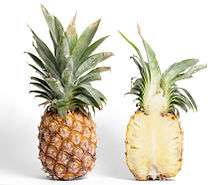
| Nutritional value per 100 g (3.5 oz) | |
|---|---|
| Energy | 209 kJ (50 kcal) |
13.12 g | |
| Sugars | 9.85 g |
| Dietary fiber | 1.4 g |
0.12 g | |
0.54 g | |
| Vitamins | Quantity %DV† |
| Thiamine (B1) | 7% 0.079 mg |
| Riboflavin (B2) | 3% 0.032 mg |
| Niacin (B3) | 3% 0.5 mg |
| Pantothenic acid (B5) | 4% 0.213 mg |
| Vitamin B6 | 9% 0.112 mg |
| Folate (B9) | 5% 18 μg |
| Choline | 1% 5.5 mg |
| Vitamin C | 58% 47.8 mg |
| Minerals | Quantity %DV† |
| Calcium | 1% 13 mg |
| Iron | 2% 0.29 mg |
| Magnesium | 3% 12 mg |
| Manganese | 44% 0.927 mg |
| Phosphorus | 1% 8 mg |
| Potassium | 2% 109 mg |
| Sodium | 0% 1 mg |
| Zinc | 1% 0.12 mg |
| Other constituents | Quantity |
| Water | 86.00 g |
| |
| †Percentages are roughly approximated using US recommendations for adults. | |
The flesh and juice of the pineapple are used in cuisines around the world. In many tropical countries, pineapple is prepared and sold on roadsides as a snack. It is sold whole or in halves with a stick inserted. Whole, cored slices with a cherry in the middle are a common garnish on hams in the West. Chunks of pineapple are used in desserts such as fruit salad, as well as in some savory dishes, including pizza toppings, or as a grilled ring on a hamburger. Traditional dishes that use pineapple include hamonado, afritada, kaeng som pla, and Hawaiian haystack. Crushed pineapple is used in yogurt, jam, sweets, and ice cream. The juice of the pineapple is served as a beverage, and it is also the main ingredient in cocktails such as the piña colada and in the drink tepache.
In the Philippines, a traditional jelly-like dessert called nata de piña has also been produced since the 18th century. It is made by fermenting pineapple juice with Komagataeibacter xylinus.[48]
Pineapple vinegar is an ingredient found in Honduran, and Filipino cuisine, where it is produced locally.[49] In Mexico it is usually made with peels from the whole fruit, rather than the juice, but in Taiwanese cuisine it is often produced by blending pineapple juice with grain vinegar.[50][51]
The European Union consumed 50% of global total for pineapple juice in 2012–2016. The Netherlands was the largest importer of pineapple juice in Europe. Thailand, Costa Rica and the Netherlands are the major suppliers to the European Union market in 2012–2016.[52] Countries consuming the most pineapple juice in 2017 were Thailand, Indonesia and the Philippines, having combined consumption of 47% of the world total. From 2007–2017, the largest growth in pineapple juice consumption was by Angola. The consumption of pineapple juice in China and India is low compared to their populations.[53]
_2.jpg) Chicken afritada (Philippines)
Chicken afritada (Philippines)- Tepache (Mexico)
.jpg) Pininyahang manok (Philippines)
Pininyahang manok (Philippines) Pineapple pizza
Pineapple pizza- Kaeng som pla (Thailand)
Nutrition
Raw pineapple pulp is 86% water, 13% carbohydrates, 0.5% protein, and contains negligible fat (table). In a 100-gram reference amount, raw pineapple supplies 50 calories, and is a rich source of manganese (44% Daily Value, DV) and vitamin C (58% DV), but otherwise contains no micronutrients in significant amounts.[54]
| Pineapple production – 2018 | |
|---|---|
| Country | (millions of tonnes) |
| Source: FAOSTAT of the United Nations[55] | |
Production
In 2018, world production of pineapples was 27.9 million tonnes, led by Costa Rica, the Philippines, Brazil, and Thailand as the largest producers.[55]
Cultivation
In commercial farming, flowering can be induced artificially, and the early harvesting of the main fruit can encourage the development of a second crop of smaller fruits. Once removed during cleaning, the top of the pineapple can be planted in soil and a new plant will grow. Slips and suckers are planted commercially.[2]
.jpg)
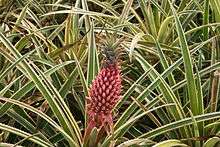
Ethical and environmental concerns
Like most modern fruit production, pineapple plantations are highly industrialized operations. Growers use toxic pesticides extensively, and run-off can flow into drinking water supplies. Workers, frequently economic migrants, are poorly paid by the standards of Western, developed nations.[56]
Historically, tropical fruit agriculture, such as for pineapples, has been concentrated in so-called "banana republics."[57][58] In 2010, 60% of pineapples consumed in Europe were grown in Costa Rica.[56]
Cultivars
Many cultivars are known.[2] The leaves of the commonly grown "smooth cayenne" are smooth,[59] and it is the most commonly grown worldwide. Many cultivars have become distributed from its origins in Paraguay and the southern part of Brazil, and later improved stocks were introduced into the Americas, the Azores, Africa, India, Malaysia and Australia.[2] Varieties include:
- "Hilo" is a compact, 1.0- to 1.5-kg (2– to 3-lb) Hawaiian variant of smooth cayenne; the fruit is more cylindrical and produces many suckers, but no slips.
- "Kona sugarloaf", at 2.5 to 3.0 kg (5–6 lb), has white flesh with no woodiness in the center, is cylindrical in shape, and has a high sugar content but no acid; it has an unusually sweet fruit.
- "Natal queen", at 1.0 to 1.5 kg (2 to 3 lb), has golden yellow flesh, crisp texture, and delicate mild flavor; well-adapted to fresh consumption, it keeps well after ripening. It has spiny leaves, and is grown in Australia, Malaysia, and South Africa.
- "Pernambuco" ("eleuthera") weighs 1–2 kg (2–4 lb), and has pale yellow to white flesh. It is sweet, melting in texture, and excellent for eating fresh; it is poorly adapted for shipping, has spiny leaves, and is grown in Latin America.
- "Red Spanish", at 1–2 kg (2–4 lb), has pale yellow flesh with a pleasant aroma, is squarish in shape, and well-adapted for shipping as fresh fruit to distant markets; it has spiny leaves and is grown in Latin America and the Philippines. It was the original pineapple cultivar in the Philippines grown for their leaf fibers (piña) in the traditional Philippine textile industry.[24][46]
- "Smooth cayenne", a 2.5- to 3.0-kg (5- to 6-lb), pale yellow– to yellow-fleshed, cylindrical fruit with high sugar and acid content, is well-adapted to canning and processing; its leaves are without spines. It is an ancient cultivar developed by Amerind peoples.[60] In some parts of Asia, this cultivar is known as Sarawak, after an area of Malaysia in which it is grown.[61] It is one of the ancestors of cultivars "73-50" (also called "MD-1" and "CO-2") and "73–114" (also called "MD-2").[60] Smooth cayenne was previously the variety produced in Hawaii, and the most easily obtainable in U.S. grocery stores, but was replaced over the course of the mid-1990s and 2000s by MD-2.[60]
- Some Ananas species are grown as ornamentals for color, novel fruit size, and other aesthetic qualities.
In the US, in 1986, the Pineapple Research Institute was dissolved and its assets divided between Del Monte and Maui Land and Pineapple. Del Monte took cultivar '73–114', dubbed 'MD-2', to its plantations in Costa Rica, found it to be well-suited to growing there, and launched it publicly in 1996 as 'Gold Extra Sweet', while Del Monte also began marketing '73–50', dubbed 'CO-2', as 'Del Monte Gold'.[60]

_2014-07-14_20-40.jpg) Abacaxi
Abacaxi- Tropical Gold
 Victoria
Victoria
Phytochemistry
Pineapple fruits and peels contain diverse phytochemicals, among which are polyphenols, including gallic acid, syringic acid, vanillin, ferulic acid, sinapic acid, coumaric acid, chlorogenic acid, epicatechin, and arbutin.[62][63]
Bromelain
Present in all parts of the pineapple plant,[64] bromelain is a mixture of proteolytic enzymes. Bromelain is under preliminary research for a variety of clinical disorders, but to date has not been adequately defined for its effects in the human body.[65] Bromelain may be unsafe for some users, such as in pregnancy, allergies, or anticoagulation therapy.[65]
If having sufficient bromelain content, raw pineapple juice may be useful as a meat marinade and tenderizer.[66] Although pineapple enzymes can interfere with the preparation of some foods or manufactured products, such as gelatin-based desserts or gel capsules,[67] their proteolytic activity responsible for such properties may be degraded during cooking and canning. The quantity of bromelain in a typical serving of pineapple fruit is probably not significant, but specific extraction can yield sufficient quantities for domestic and industrial processing.[66][68]
Pests and diseases
Pineapples are subject to a variety of diseases, the most serious of which is wilt disease vectored by mealybugs[69] typically found on the surface of pineapples, but possibly in the closed blossom cups.[2] Other diseases include citrus pink disease, bacterial heart rot, anthracnose,[69] fungal heart rot, root rot, black rot, butt rot, fruitlet core rot, and yellow spot virus.[70] Pineapple pink disease (not citrus pink disease) is characterized by the fruit developing a brownish to black discoloration when heated during the canning process. The causal agents of pink disease are the bacteria Acetobacter aceti, Gluconobacter oxydans, Pantoea citrea.[71][72] and Tatumella ptyseos.[73][74]
Some pests that commonly affect pineapple plants are scales, thrips, mites, mealybugs, ants, and symphylids.[70]
Heart-rot is the most serious disease affecting pineapple plants. The disease is caused by Phytophthora cinnamoni and P. parasitica, fungi that often affect pineapples grown in wet conditions. Since it is difficult to treat, it is advisable to guard against infection by planting resistant cultivars where these are available; all suckers that are required for propagation should be dipped in a fungicide, since the fungus enters through the wounds.[75]
Storage and transport
Some buyers prefer green fruit, others ripened or off-green. A plant growth regulator, Ethephon, is typically sprayed onto the fruit one week before harvest, developing ethylene, which turns the fruit golden yellow. After cleaning and slicing, a pineapple is typically canned in sugar syrup with added preservative.[2]
A pineapple never becomes any riper than it was when harvested.[76]
The fruit itself is quite perishable[2] and if it is stored at room temperature, it should be used within two days; however, if it is refrigerated, the time span extends to 5–7 days.
Textiles
The 'Red Spanish' cultivar of pineapples were once extensively cultivated in the Philippines. The long leaves of the cultivar were the source of traditional piña fibers, an adaptation of the native weaving traditions with fibers extracted from abacá. These were woven into lustrous lace-like nipis fabrics usually decorated with intricate floral embroidery known as calado and sombrado. The fabric was a luxury export from the Philippines during the Spanish colonial period and gained favor among European aristocracy in the 18th and 19th centuries. Domestically, they were used to make the traditional barong tagalog, baro't saya, and traje de mestiza clothing of the Filipino upper class, as well as women's kerchiefs (pañuelo). They were favored for their light and breezy quality, which was ideal in the hot tropical climate of the islands. The industry was destroyed in the Second World War and is only starting to be revived.[24][46][77]
 1895 painting of a Filipina in traditional traje de mestiza dress
1895 painting of a Filipina in traditional traje de mestiza dress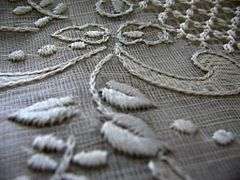 Calado embroidery on a barong tagalog
Calado embroidery on a barong tagalog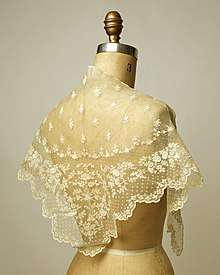 Early 19th century pañuelo in the Metropolitan Museum of Art
Early 19th century pañuelo in the Metropolitan Museum of Art%2C_19th_century_(CH_18386747).jpg) 19th century handkerchief in the Cooper Hewitt, Smithsonian Design Museum
19th century handkerchief in the Cooper Hewitt, Smithsonian Design Museum
Gallery
.jpg) A pineapple
A pineapple Pineapple detail
Pineapple detail Pineapple leaf detail
Pineapple leaf detail
References
- "The Plant List: A Working List of All Plant Species". Retrieved 25 July 2014.
- Morton, Julia F (1987). "Pineapple, Ananas comosus". Retrieved 22 April 2011.
- "Pineapple Definition | Definition of Pineapple at Dictionary.com". Dictionary.reference.com. Retrieved 6 December 2009.
- Coppens d'Eeckenbrugge, G; Leal, F. (2003). "Chapter 2: Morphology, Anatomy, and Taxonomy". In Bartholomew, DP; Paull, RE; Rohrbach, KG (eds.). The Pineapple: Botany, Production, and Uses. Wallingford, UK: CABI Publishing. p. 21. ISBN 978-0-85199-503-8.
- "Pineapple production in 2016, Crops/Regions/World list/Production Quantity (pick lists)". UN Food and Agriculture Organization, Corporate Statistical Database (FAOSTAT). 2017. Retrieved 23 February 2018.
- "How to grow a pineapple in your home". Pineapple Working Group-International Horticultural Society. Retrieved 15 August 2010.
- "Pineapple Growing". Tropical Permaculture.com (Birgit Bradtke). Archived from the original on 17 June 2010. Retrieved 15 August 2010.
- Jones, J.; Wilson, W (2006). "Chapter 11: Science". An Incomplete Education. Ballantine. p. 544. ISBN 978-0-7394-7582-9.
- Gibson, Arthur C. "Pineapple – The Plant That Ate Hawai'i". UCLA. Archived from the original on 4 March 2016.
- Bartholomew, D. P.; Paull, Robert E.; Rohrbach, K. G. (2002). The Pineapple: Botany, Production, and Uses. CABI. p. 23. ISBN 9780851999791.
- Stahl, JM; Nepi, M; Galetto, L; Guimarães, E; Machado, SR (2012). "Functional aspects of floral nectar secretion of Ananas ananassoides, an ornithophilous bromeliad from the Brazilian savanna". Annals of Botany. 109 (7): 1243–1252. doi:10.1093/aob/mcs053. PMC 3359915. PMID 22455992.
- Aziz SA, Olival KJ, Bumrungsri S, Richards GC, Racey PA (2016). "The Conflict Between Pteropodid Bats and Fruit Growers: Species, Legislation and Mitigation". In Voigt C, Kingston T (eds.). Bats in the Anthropocene: Conservation of Bats in a Changing World. Springer. pp. 377–426. doi:10.1007/978-3-319-25220-9_13. ISBN 9783319252209.
- Bartholomew DP; Hawkins RA; Lopez JA (2012). "Hawaii Pineapple: The Rise and Fall of an Industry". HortScience. 47 (10): 1390–1398. doi:10.21273/HORTSCI.47.10.1390. Archived from the original on 30 November 2017. Retrieved 9 December 2017.
- "List of prohibited animals" (PDF). Government of Hawaii, Department of Agriculture. 28 November 2006. Retrieved 9 December 2017.
- Grant, Jason R.; Zijlstra, Gea (1998). "An Annotated Catalogue of the Generic Names of the Bromeliaceae". Selbyana. 19 (1): 91–121. ISSN 0361-185X. JSTOR 41759978.
- Davidson A. (2008) The Penguin Companion to Food. Penguin Books.
- Oxford English Dictionary.
- Bertoni, "Contributions a l'étude botanique des plantes cultivées. Essai d'une monographie du genre Ananas", Annales Cient. Paraguay (2nd series) 4 (1919:250–322).
- KF Baker, JL Collins, "Notes on the distribution and ecology of Ananas and Pseudananas in South America", American Journal of Botany, 1939; Collins, The pineapple: botany, utilization, cultivation, (London:Leonard Hill) JL. 1960.
- Pickersgill, B (1976). "Pineapple". Evolution of Crop Plants, N. W. Simmonds, Ed.
- Morrison, SE (1963). Journals and Other Documents of the Life of Christopher Columbus. Heritage Press.
- Rohtbach, GKG; Leal, F. (2003). "Chapter 1: History, distributions and World Production". In Bartholomew, DP; Paull, RE; Rohrbach, KG (eds.). The Pineapple: Botany, Production, and Uses. Wallingford, UK: CABI Publishing. p. 21. ISBN 978-0-85199-503-8.
- Collingham, L (2007). Curry: a Tale of Cooks and Conquerors. Oxford: Oxford University Press. ISBN 978-0-19-532001-5.
- "History & Origin of Piña". Philippine Folklife Museum Foundation. Retrieved 13 December 2018.
- "The History of Pineapple in the Philippines". Filipino Yum!. Retrieved 13 December 2018.
- Hayward, Wyndham (1956). "The Pineapple meets the Press". 6. Cite journal requires
|journal=(help) - Christopher Cumo, Foods that Changed History: How Foods Shaped Civilization from the Ancient World to the Present (ABC-CLIO, 2015), p. 294.
- "Oxford Index – Pieter de La Court van der Voort". oxfordindex.oup.com. Oxford University Press. Retrieved 15 December 2014.
- Beauman, F (2005). The Pineapple: King of Fruits. London: Chatto & Windus. p. 82. ISBN 978-0-7011-7699-0.CS1 maint: ref=harv (link)
- Mimi Sheller, Consuming the Caribbean: From Arawaks to Zombies (Routledge: 2003), p. 80.
- Beauman (2005), p. 89.
- Beauman (2005), p. 87.
- Stevenson, Jack, Exploring Scotland's Heritage: Glasgow, Clydesdale and Stirling. Her Majesty's Stationery Office, 1995 (p. 83).
- James Stevens Curl, Classical Architecture: An Introduction to Its Vocabulary and Essentials, with a Select Glossary of Terms (W. W. Norton: 2003), p. 206.
- Hugh Morrison, Early American Architecture: From the First Colonial Settlements to the National Period (Oxford University Press, 1952), p. 302.
- Cyril Manton Harris, American Architecture: An Illustrated Encyclopedia (W. W. Norton: 1998), p. 248.
- Brad Matthews; Paul Wigsten (9 February 2010). Kitchen Pro Series: Guide to Produce Identification, Fabrication and Utilization. Cengage Learning. p. 269. ISBN 978-1-4354-0121-1.
- Hawkins, Richard (2007). "James D Dole and the 1932 Failure of the Hawaiian Pineapple Company". Hawaiian Journal of History. 41: 149–170.
- "Pineapple". Faculty.ucc.edu. Archived from the original on 21 December 2009. Retrieved 6 December 2009.
- "Sunrise, Sunset". Hawaii Business. 46 (2): 60. 2000.
- Rhodes J (20 March 2013). "It's Pineapple Season, But Does Your Fruit Come From Hawaii?". Smithsonian Institution. Retrieved 29 December 2015.
- Gary T Kubota (24 December 2009). "Maui Pineapple harvests final crop". Honolulu Star-Bulletin. Retrieved 9 November 2010.
- The Agriculture of Hawaii: Hawaii Pineapples, To-Hawaii.com; accessed 2018.08.28.
- E.g., Duane P. Bartholomew, Richard A. Hawkins, and Johnny A. Lopez, "Hawaii Pineapple: The Rise and Fall of an Industry Archived 30 November 2017 at the Wayback Machine", HortScience Vol. 47, No. 10, pp. 1390-1398 (October 2012).
- "Hawaiian Dessert Pineapple Recipes" Yummly.com; accessed 2018.08.28.
- Ewbank, Anne (6 September 2018). "This Prized Filipino Fabric Is Made From Pineapple Leaves". Gastro Obscura. Retrieved 13 December 2018.
- C. O. Sison, Ignacio (13 August 2015). SEC Form 17-A (Report). Philippine Stock Exchange. Archived from the original on 9 January 2017. Retrieved 18 January 2019.
- Vergara, Benito S.; Idowu, Panna Melizah H.; Sumangil, Julia H. (1999). Nata de Coco: A Filipino Delicacy (PDF). National Academy of Sciences and Technology, Philippines. ISBN 9718538615.
- Clutton, Angela. The Vinegar Cupboard: Recipes and history of an everyday ingredient. Bloomsbury. p. 57. Retrieved 3 February 2020.
- Chang, R.C. Vinegars of the World. p. 228. Retrieved 3 February 2020.
- Kennedy, Diana. The Essential Cuisines of Mexico: A Cookbook. p. 496.
- Exporting pineapple juice to Europe CBI Ministry of Foreign Affairs Retrieved 22 May 2019
- Population growth drives gradual expansion of pineapple juice market Archived 27 May 2020 at the Wayback Machine AgriOrbit Retrieved 22 May 2019
- "Nutrient data for pineapple, raw, all varieties, per 100 g serving". Nutritiondata.com, USDA SR-21. Retrieved 1 March 2012.
- "Pineapple production in 2018, Crops/Regions/World list/Production Quantity (pick lists)". UN Food and Agriculture Organization, Corporate Statistical Database (FAOSTAT). 2019. Retrieved 8 March 2020.
- Felicity Lawrence (2 October 2010). "Bitter Fruit". London: Guardian News and Media Limited. (But note that Dole contests these claims; see, for example, the summary in Russ Martin (8 October 2010). "Dole Responds to Costa Rican Pineapple Criticism". Fijatevos.com – Costa Rica. Archived from the original on 23 November 2010.).
- Chapman, Peter (2009). Jungle capitalists : a story of globalisation, greed and revolution. Edinburgh New York: Canongate. p. 6. ISBN 978-1847676863.
- Big Fruit Archived 2017-03-13 at the Wayback Machine, NY Times
- Kochhar, SL (2006). Economic Botany in the Tropics. Nature. 144. p. 203. Bibcode:1939Natur.144..563.. doi:10.1038/144563a0. ISBN 978-0-333-93118-9.
- Duane P. Bartholomew (2009). "'MD-2' Pineapple Transforms the World's Pineapple Fresh Fruit Export Industry" (PDF). Pineapple News. 16: 2–5. Retrieved 3 September 2014.
- "PINEAPPLE – Common Varieties | TFNet – International Tropical Fruits Network". www.itfnet.org. 10 May 2016. Retrieved 18 October 2017.
- Li, Ti; Shen, Peiyi; Liu, Wei; Liu, Chengmei; Liang, Ruihong; Yan, Na; Chen, Jun (2014). "Major Polyphenolics in Pineapple Peels and their Antioxidant Interactions". International Journal of Food Properties. 17 (8): 1805. doi:10.1080/10942912.2012.732168.
- Ogawa, E. M; Costa, H. B; Ventura, J. A; Caetano, L. C; Pinto, F. E; Oliveira, B. G; Barroso, M. E. S; Scherer, R; Endringer, D. C; Romão, W (2018). "Chemical profile of pineapple cv. Vitória in different maturation stages using electrospray ionization mass spectrometry". Journal of the Science of Food and Agriculture. 98 (3): 1105–1116. doi:10.1002/jsfa.8561. PMID 28722812.
- Arshad ZI, Amid A, Yusof F, Jaswir I, Ahmad K, Loke SP (2014). "Bromelain: an overview of industrial application and purification strategies" (PDF). Appl Microbiol Biotechnol. 98 (17): 7283–97. doi:10.1007/s00253-014-5889-y. PMID 24965557.
- "Bromelain". MedlinePlus, US National Institutes of Health. 2015. Retrieved 8 May 2015.
- Chaurasiya RS, Sakhare PZ, Bhaskar N, Hebbar HU (2015). "Efficacy of reverse micellar extracted fruit bromelain in meat tenderization". J Food Sci Technol. 52 (6): 3870–80. doi:10.1007/s13197-014-1454-z. PMC 4444899. PMID 26028772.
- Marques MR (2014). "Enzymes in the dissolution testing of gelatin capsules". AAPS PharmSciTech. 15 (6): 1410–6. doi:10.1208/s12249-014-0162-3. PMC 4245433. PMID 24942315.
- Arshad ZI, Amid A, Yusof F, Jaswir I, Ahmad K, Loke SP (2014). "Bromelain: an overview of industrial application and purification strategies" (PDF). Appl Microbiol Biotechnol. 98 (17): 7283–97. doi:10.1007/s00253-014-5889-y. PMID 24965557.
- "Diseases of Pineapple (Ananas comosus (L.) Merr.)". Apsnet.org. Archived from the original on 30 November 2011. Retrieved 28 March 2011.
- Pests and Diseases of Pineapple: Food Market Exchange – B2B e-marketplace for the food industry Archived 25 July 2011 at the Wayback Machine. Food Market Exchange. Retrieved on 2 October 2011.
- Cha, J.-S.; Pujol, C.; Dususin, A.R.; Macion, E.A.; Hubbard, C.H.; Kado, C.I. (1997). "Studies on Pantoea citrea, the causal agent of pink disease of pineapple". Journal of Phytopathology. 145 (7): 313–319. doi:10.1111/j.1439-0434.1997.tb00407.x.
- Pujol, C.J.; Kado, C.I. (1999). "gdhB, a gene encoding a second quinoprotein glucose dehydrogenase in Pantoea citrea, is required for pink disease of pineapple". Microbiology. 145 (5): 1217–1226. doi:10.1099/13500872-145-5-1217. PMID 10376838.
- Marin-Cevada, V.; Caballero-Mellado, Jesús; Bustillos-Cristales, R.; Muñoz-Rojas, J.; Mascarúa-Esparza, M.A; Castañeda-Lucio, M.; López-Reyes, L.; Martínez-Aguilar, L.; Fuentes-Ramírez, L.E. (2010). "Tatumella ptyseos, an unrevealed causative agent of Pink disease in pineapple". Journal of Phytopathology. 158 (2): 93–99. doi:10.1111/j.1439-0434.2009.01575.x.
- Marín-Cevada, V.; Fuentes-Ramírez, L.E. (2016). "Pink disease, a review of an asymptomatic bacterial disease in pineapple". Revista Brasileira de Fruticultura. 38 (3): e949. doi:10.1590/0100-29452016949.
- Brickell, Christopher (1996). Encyclopedia of Gardening. 9 Henrietta Street, London WC2 8PS: Dorling Kindersley Publishers Limited. p. 419. ISBN 978-1-85833-579-7.CS1 maint: location (link)
- Sheraton, Mimi (21 April 1982). "A guide to choosing a ripe pineapple". The New York Times.
- "piña cloth". Free Online Dictionary, Thesaurus and Encyclopedia. The Free Dictionary. Retrieved on 6 November 2014 from http://www.thefreedictionary.com/pi%C3%B1a+cloth.
Bibliography
- Menzel, Christopher. "Tropical and Subtropical Fruit". Encyclopedia of Agricultural Science Volume 4. ISBN 0122266706. Charles J Arntzen. New York: Elsevier Science Publishing Co. Inc., Academic Press, 2012. 380–382.
External links
| Wikimedia Commons has media related to Pineapples. |
- Pineapple Fruit Facts—information on pineapples from California Rare Fruit Growers
- "The Strange History of the 'King-Pine'" from The Paris Review
